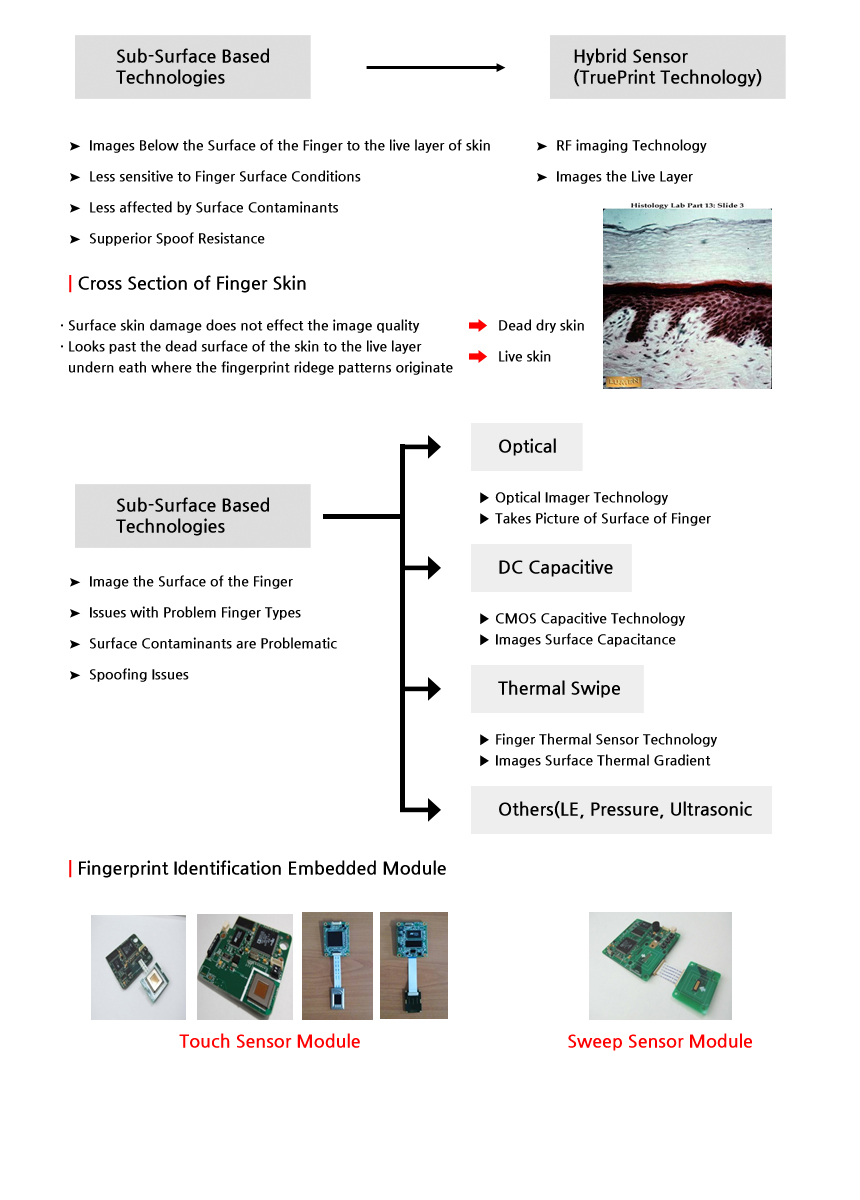|
| Fingerprint?
Human fingerprints are detailed, unique, difficult to alter, and durable over the life of an individual, making them suitable as long-term markers of human identity.
| Fingerprint recognition?
In biometrics, minutiae are major features of a fingerprint, using which comparisons of one print with another can be made. Minutiae include: • Ridge ending – the abrupt end of a ridge
| Fingerprint patterns?
There are three main fingerprint patterns: arches, loops and whorls. Arches are found in about 5% of fingerprint patterns encountered. The ridges run from one side to the other of the pattern, making no backward turn. Ordinarily, there is no delta in an arch pattern but where there a delta, no re-curving ridge must intervene between the core and delta points. There are four types of arch patterns: plain arches, radial arches, ulnar arches and tented arches. Plain arches have an even flow of ridges from one side to the other of the pattern, no "significant up thrusts" and the ridges enter on one side of the impression, and flow out the other with a rise or wave in the center. The ridges of radial arches slope towards the thumb, have one delta and no re-curving ridges. On ulnar arches, the ridges slope towards the little finger, have one delta and no re-curving ridges. Tented arches have an angle, an up thrust, or two of the three basic characteristics of the loop. They don't have the same "easy" flow that plain arches do and particularly have "significant up thrusts" in the ridges near the middle that arrange themselves on both sides of a spine or axis towards which the adjoining ridges converge and appear to form tents.
| ||||||||||||||||||||||||||||||||||||||||||||||||||||||||||||||||||||||||||||||
| ||||||||||||||||||||||||||||||||||||||||||||||||||||||||||||||||||||||||||||||
|
Loops occur in about 60-70 % of fingerprint patterns encountered. One or more of the ridges enters on either side of the impression, re-curves, touches or crosses the line running from the delta to the core and terminates on or in the direction of the side where the ridge or ridges entered. Each loop pattern has is one delta and one core and has a ridge count. Radial loops are named after the radius, a bone in the forearm that joins the hand on the same side as the thumb. The flow of the pattern in radial loops runs in the direction of the radius (toward the thumb). Radial loops are not very common and most of the time radial loops will be found on the index fingers. Ulnar loops are named after the ulna, a bone in the forearm. The ulna is on the same side as the little finger and the flow of the pattern in a ulnar loop runs in the direction of the ulna (toward the little finger).
| ||||||||||||||||||||||||||||||||||||||||||||||||||||||||||||||||||||||||||||||
| ||||||||||||||||||||||||||||||||||||||||||||||||||||||||||||||||||||||||||||||
|
Whorls are seen in about 25-35 % of fingerprint patterns encountered. In a whorl, some of the ridges make a turn through at least one circuit. Any fingerprint pattern which contains 2 or more deltas will be a whorl pattern. There are four types of whorl patterns. Plain whorls consist of one or more ridges which make or tend to make a complete circuit with two deltas, between which an imaginary line is drawn and at least one re-curving ridge within the inner pattern area is cut or touched.
Central pocket loop whorls consist of at least one re-curving ridge or an obstruction at right angles to the line of flow, with two deltas, between which when an imaginary line is drawn, no re-curving ridge within the pattern area is cut or touched.
Central pocket loop whorl ridges make one complete circuit which may be spiral, oval, circular or any variant of a circle.
Double loop whorls consist of two separate and distinct loop formations with two separate and distinct shoulders for each core, two deltas and one or more ridges which make, a complete circuit.
Between the two at least one re-curving ridge within the inner pattern area is cut or touched when an imaginary line is drawn.
Accidental whorls consist of two different types of patterns with the exception of the plain arch, have two or more deltas or a pattern which possess some of the requirements for two or more different types or a pattern which conforms to none of the definitions. | ||||||||||||||||||||||||||||||||||||||||||||||||||||||||||||||||||||||||||||||
| ||||||||||||||||||||||||||||||||||||||||||||||||||||||||||||||||||||||||||||||
|
| Fingerprint Identification process
Fingerprint image capture → Image calculation → Image strengthen → Binarization → Thinning process → Minutiae extraction → Minutiae matching
| Fingerprint identification system configuration
• Power and system input section : Power supply, emergency power supply, function input section
| Fingerprint sensor comparison
| Fingerprint Identification Algorithm
| ||||||||||||||||||||||||||||||||||||||||||||||||||||||||||||||||||||||||||||||
| | Fingerprint Sensor Technologies | ||||||||||||||||||||||||||||||||||||||||||||||||||||||||||||||||||||||||||||||
 | ||||||||||||||||||||||||||||||||||||||||||||||||||||||||||||||||||||||||||||||
| ||||||||||||||||||||||||||||||||||||||||||||||||||||||||||||||||||||||||||||||
|
| Field Test Data of PED-5000F 1. Composition per Fingerprint pattern
2. Acceptance ratio per age
| ||||||||||||||||||||||||||||||||||||||||||||||||||||||||||||||||||||||||||||||
|
3. Test Data (Ratio of Fingerprint Identification per Temperature)
Remark 1. Sample per age(1,000): Under 20age(200), 20~40age (500), 50~60age(200) 70~80age(100)
| Fingerprint door lock comparing chart with competitor
| ||||||||||||||||||||||||||||||||||||||||||||||||||||||||||||||||||||||||||||||
| ||||||||||||||||||||||||||||||||||||||||||||||||||||||||||||||||||||||||||||||
